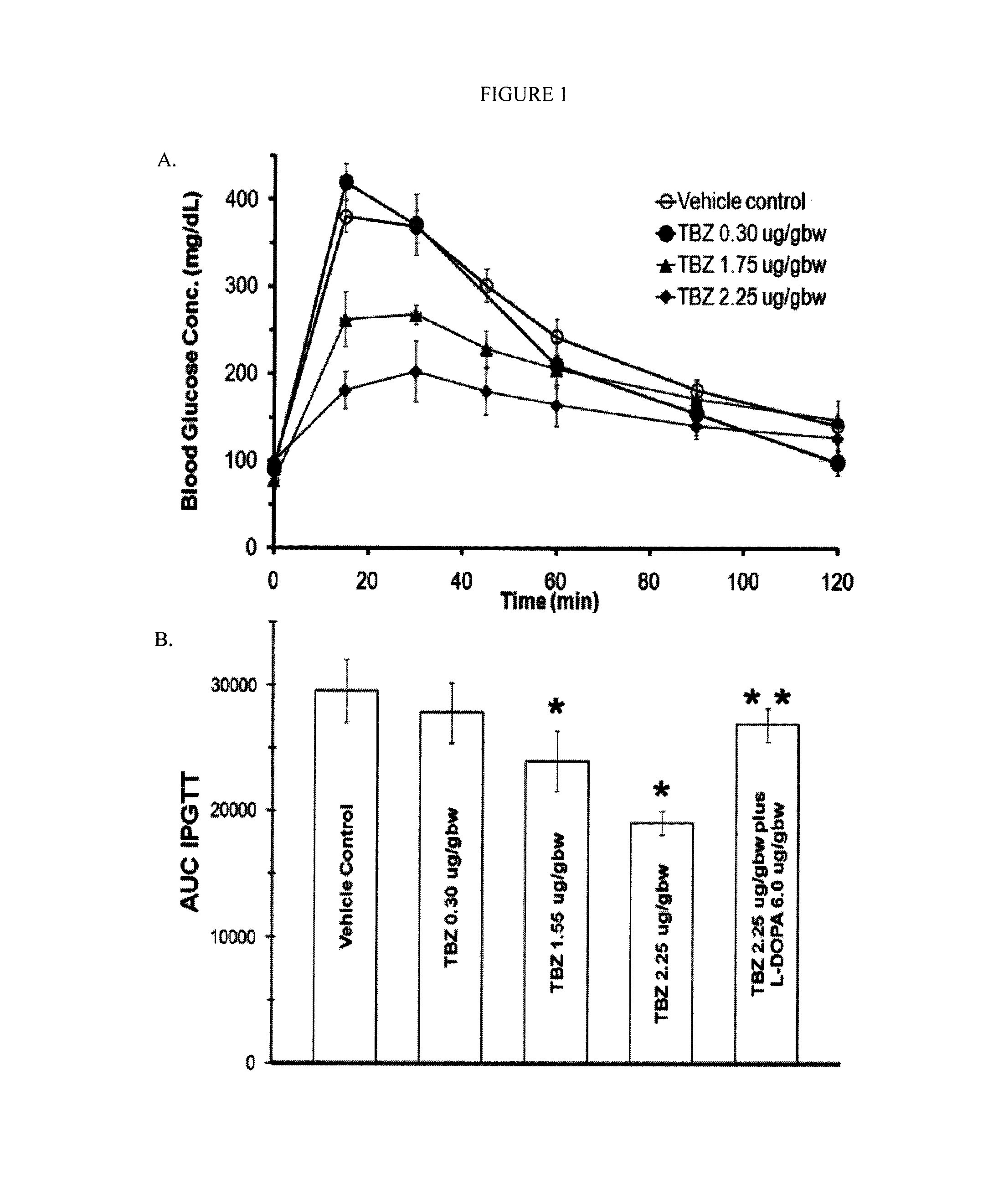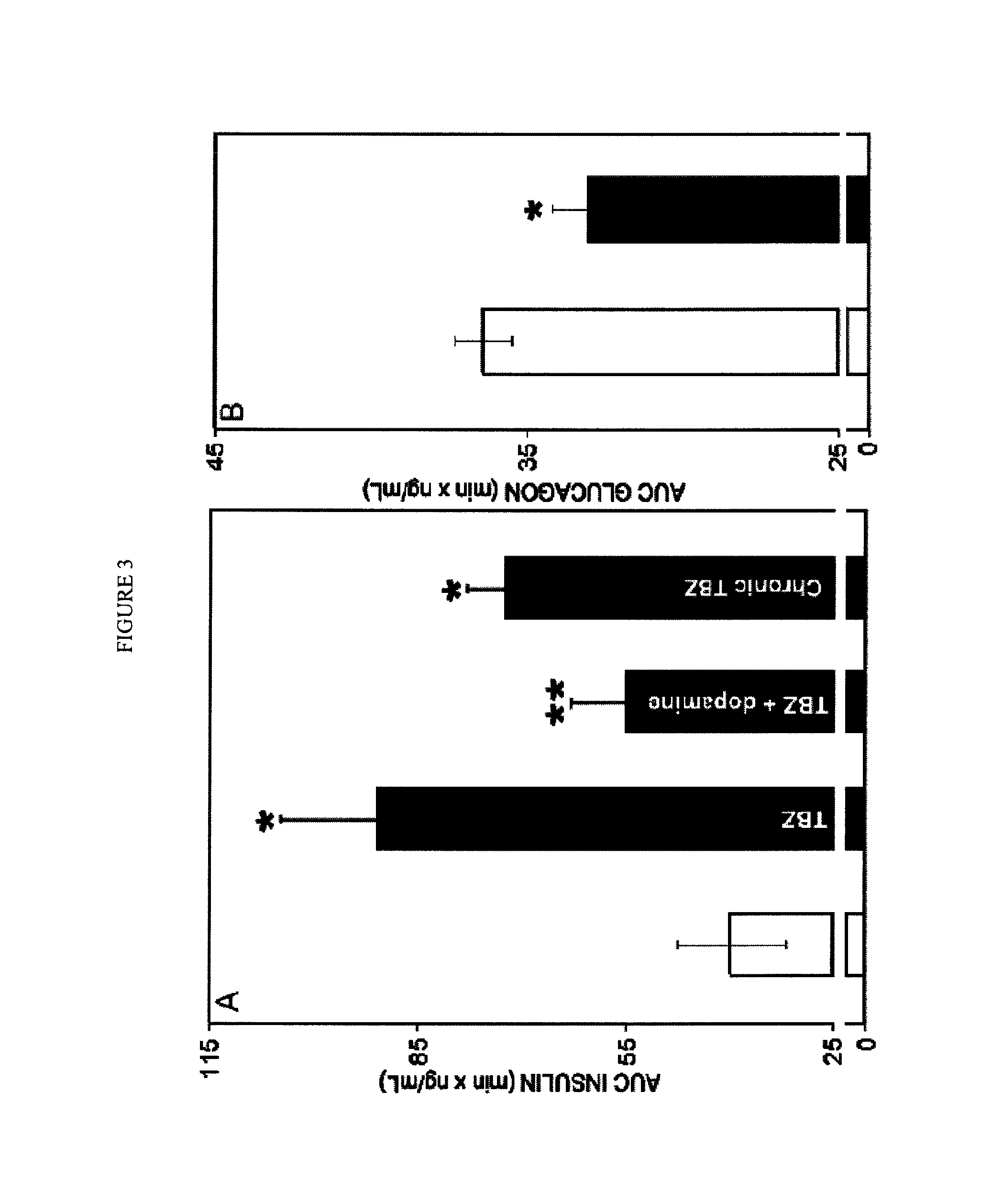Glucose metabolism modulating compounds
a technology of glucose metabolism and modulating compounds, applied in the direction of biocide, drug composition, metabolism disorder, etc., can solve the problem that the medical need remains largely unmet, and achieve the effect of preventing cross-contamination
- Summary
- Abstract
- Description
- Claims
- Application Information
AI Technical Summary
Problems solved by technology
Method used
Image
Examples
example 1
Materials and Methods
Drugs and Reagents
[0152]L-epinephrine bitartrate, D-glucose, L-DOPA, sodium citrate were obtained from Sigma Chemicals.
[0153]All cell culture media and supplements were obtained from Invitrogen (Carlsbad, Calif.). Tissue culture plates were obtained from Falconware (Becton-Dickinson, Inc., Oxnard, Calif.). Tetrabenazine and dihydrotetrabenazine were obtained from the National Institute of Mental Health's Chemical Synthesis and Drug Supply Program or Tocris Bioscience (Ellisville, Mo.). All other chemicals (other than the compounds synthesized as described below) were of the highest commercial quality available.
Experimental Animals
[0154]All animal studies were reviewed and approved by the Institutional Animal Care and Use Committee (IACUC) at Columbia University's College of Physicians and Surgeons. All experiments were performed in accordance with ‘Principles of laboratory animal care’ (NIH publication no. 85-23, revised 1985). Normal male Lewis rats were obtain...
example 2
Glucose Tolerance in Adult Lewis Rats is Improved by TBZ
[0172]Older heavier Lewis rats display glucose intolerance relative to younger animals during an IPGTT (Natalucci, et al. 2003; Wang, et al. 1997). To explore the role of VMAT2 in insulin secretion, and to better demonstrate the possible value of VMAT2 as a potential therapeutic target, older male Lewis rats (300-500 grams, >11 weeks of age) were selected for IPGTT testing. For this study only rats with vehicle-alone AUC IPGTT values greater than 10 g / dL×min were used. Doses of tetrabenazine (TBZ) were selected that were approximately three to ten fold higher than the equivalent doses currently used in humans to treat movement disorders (Kenney and Jankovic 2006). Following TBZ administration (about 1 hour), but before glucose challenge, no reproducible differences were found in the baseline fasting glucose concentrations of control animals (data not shown). Following TBZ treatment and glucose challenge, however, a significant ...
example 3
TBZ Depletes Total Pancreatic Dopamine and L-DOPA Reverses Effects of TBZ
[0174]Dopamine is a well-known substrate of VMAT2-mediated vesicular transport (Howell, et al., 1994) and one of the main reported actions of TBZ is the depletion of dopamine in brain tissue (Kenney and Jankovic 2006). To explore the possible role of dopamine in mediating the in vivo glucose tolerance enhancing effects of TBZ, the effects of TBZ on the concentration of dopamine were examined in both the pancreas and the brain. One hour after injection of TBZ, the dopamine content of both tissues was significantly reduced (FIG. 2). Because islets compose only about 2% of the pancreas, the marked effects of TBZ on total pancreatic dopamine content likely reflects dopamine depletion in non islet pancreatic tissue elements as well. The IPGTT experiments were repeated with TBZ. In these experiments, however, L-DOPA, the metabolic precursor of dopamine or a vehicle control, was administered one hour following TBZ and...
PUM
| Property | Measurement | Unit |
|---|---|---|
| with half life | aaaaa | aaaaa |
| body weight | aaaaa | aaaaa |
| body weight | aaaaa | aaaaa |
Abstract
Description
Claims
Application Information
 Login to View More
Login to View More - R&D
- Intellectual Property
- Life Sciences
- Materials
- Tech Scout
- Unparalleled Data Quality
- Higher Quality Content
- 60% Fewer Hallucinations
Browse by: Latest US Patents, China's latest patents, Technical Efficacy Thesaurus, Application Domain, Technology Topic, Popular Technical Reports.
© 2025 PatSnap. All rights reserved.Legal|Privacy policy|Modern Slavery Act Transparency Statement|Sitemap|About US| Contact US: help@patsnap.com



